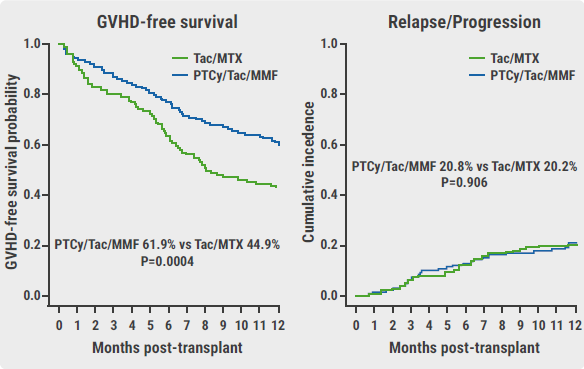https://doi.org/10.55788/8f92ebac
“Infections are a major cause of morbidity and mortality during neutropenia, following SCT,” said Prof. Federico Stella (Università degli Studi di Milano, Italy). Restrictive diets are widely used in centres performing SCT to prevent infections [1]. However, according to Prof. Stella, evidence for the efficacy of these practices is lacking. The non-inferiority, phase 3 Neutrodiet trial aimed to address this issue [2]. Patients who underwent an autologous or allogeneic SCT (n=230) were randomised 1:1 to a protective diet or an unrestricted diet. In the protective diet arm, the patients’ food was cooked >80°C unless it was thick peel fruit. Furthermore, yogurt, honey, cold cuts and sausages, raw fish, raw meat, raw vegetables, and raw fruits were forbidden to consume. Patients in the unrestricted diet arm did not receive raw fish or raw meat either. The primary study endpoint was the rate of grade ≥2 infections during the period of neutropenia.
No difference was observed in the rate of grade ≥2 infections between the protective diet arm and the non-restricted diet arm (65% vs 62%; RR 1.0; 95% CI 0.8–1.3; P=0.8). In addition, severe infections, gastrointestinal infections, sepsis, pneumonia, and fever of undetermined origin occurred equally often in the study arms. One death was reported in the protective diet arm and no deaths were observed in the non-restricted diet arm. Furthermore, the incidence of grade ≥3 graft-versus-host disease did not significantly differ between the two arms, with a rate of 20% in the protective diet arm and a rate of 9.5% in the non-restricted diet arm (P=0.4). Dr Stella mentioned that the mean body weight loss at 1 month was lower in the non-restricted diet arm than in the protective diet arm (2.7 kg vs 3.7 kg; P=0.04). Finally, the non-restricted diet was associated with higher satisfaction rates than the protective diet.
These results support the use of a non-restricted diet in patients with neutropenia after SCT, since a protective diet does not appear to influence infection rates but alters the patients’ quality-of-life.
- Peric Z, et al. Bone Marrow Transplant. 2018;53(8):1030–1037.
- Stella F, et al. Non-Restrictive Diet Does Not Increase Infections in Patients with Neutropenia after Stem Cell Transplantation: Final Analysis of the Neutrodiet Multicenter, Randomized Trial. Abstract 169, ASH 64th Annual Meeting, 10–13 December 2022, New Orleans, LA, USA.
Copyright ©2023 Medicom Medical Publishers
Posted on
Previous Article
« Iptacopan offers solution for patients with PNH and residual anaemia after standard-of-care Next Article
Long-term benefits from beti-cel in transfusion-dependent β-thalassaemia »
« Iptacopan offers solution for patients with PNH and residual anaemia after standard-of-care Next Article
Long-term benefits from beti-cel in transfusion-dependent β-thalassaemia »
Table of Contents: ASH 2022
Featured articles
Acute Lymphoblastic Leukaemia
Blinatumomab candidate for standard-of-care in newly diagnosed B-ALL
High-dose methotrexate or standard interim maintenance in young patients with ALL?
Acute Myeloid Leukaemia
Excellent results for triplet regimen in FLT3-mutated AML
MRD by qPCR prognostic of outcomes in venetoclax-treated NPM1-mutated AML
Promising results for triplet therapy with magrolimab in AML
Should we use intensive chemotherapy prior to allo-HCT in relapsed/refractory AML?
Chronic Leukaemia
Zanubrutinib wins battle of BTK inhibitors in relapsed or refractory CLL/SLL
Ibrutinib plus venetoclax displays long-term benefits in CLL
Multiple Myeloma
Talquetamab further investigated in heavily pre-treated MM after promising phase 2 data
Promising results of elranatamab for MM in phase 2 MagnetisMM-3 trial
Deep and durable responses for quadruple therapy in smouldering MM
Ultra-sensitive MRD assessment in MM with BloodFlow
CAR-Hematotox score proves useful in relapsed/refractory MM
Head-to-head: VMP versus Rd in transplant-ineligible MM
Lymphoma
Ibrutinib added to ASCT improves clinical outcomes in mantle cell lymphoma
High-dose chemotherapy plus ASCT superior to standard immuno-chemotherapy in primary CNS lymphoma
Odronextamab has considerable anti-tumour effects in relapsed/refractory diffuse large B-cell lymphoma and follicular lymphoma
Excellent results for AFM13-complexed NK cells in CD30-positive lymphoma
CAR-Hematotox score predicts toxicity, infections, and clinical outcomes in MCL
Myeloproliferative Neoplasms
Efgartigimod successful in immune thrombocytopenia
INCA033989: novel investigational agent for CALR-mutated MPN
Ruxolitinib mediates clonal evolution of RAS pathway mutations in MPN
Immune Thrombocytopenia
Long-term risk for haematologic disease in persistent, isolated mild thrombocytopenia
Various Topics
C1 inhibitor deficiency linked to thrombosis
Durable responses to gene therapy in haemophilia A
Long-term benefits from beti-cel in transfusion-dependent β-thalassaemia
Neutrodiet: non-restricted diet is the preferred option after SCT
Iptacopan offers solution for patients with PNH and residual anaemia after standard-of-care
Novel therapy may replace standard-of-care prophylaxis for GVHD
LMWH does not result in higher live birth rates in women with inherited thrombophilia
Related Articles

February 20, 2023
Novel therapy may replace standard-of-care prophylaxis for GVHD
February 20, 2023
Neutrodiet: non-restricted diet is the preferred option after SCT
© 2024 Medicom Medical Publishers. All rights reserved. Terms and Conditions | Privacy Policy

